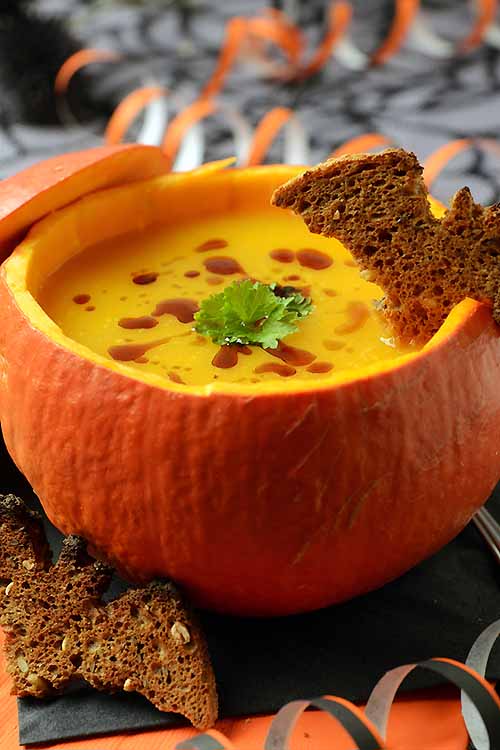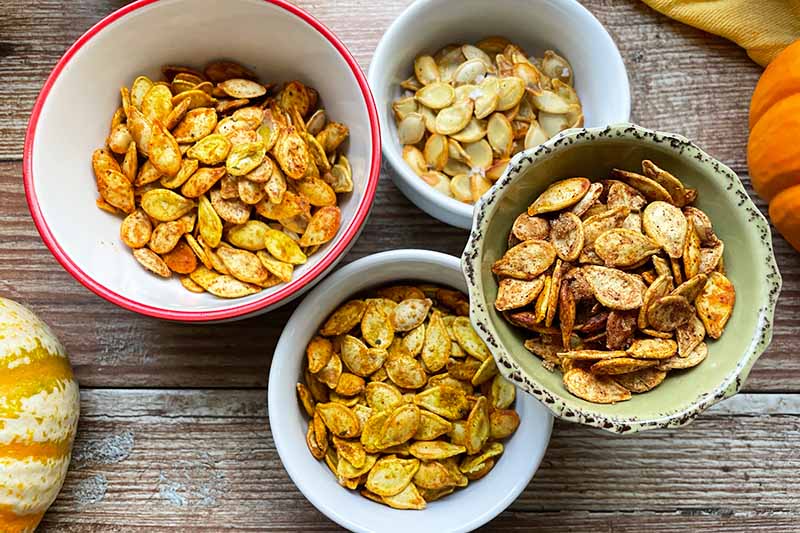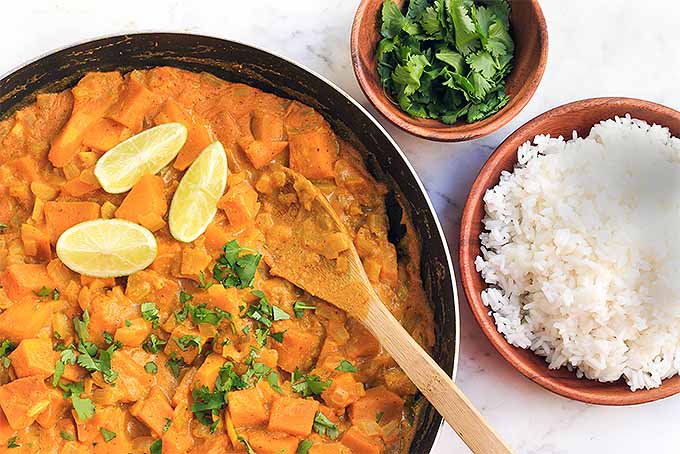A full yellow moon hangs in the night sky, half-obscured by smoky clouds.

Up and down the dimly lit street, spider webs cover bushes and trees, and vague white shapes peek out here and there from the shadows.
Strange sounds emanate from the distance, chains rattling and cackling laughter. The ambiance is eerie, macabre even, until the shrieking of children’s laughter and the sound of their running feet cut through the gloomy darkness.
Little Elsas, tiny witches, and pint-sized Batmans and Supermans come racing down the sidewalk, followed closely by their frazzled parents, and we find a felicitous explanation for such a spooky setting.
It’s Halloween!
If you’ve ever wondered where all this trick-or-treating business started, why we celebrate the holiday in the first place, or why we eat what we do during this time of year, you’ve come to the right place.
Starting at the Beginning: Samhain
The last day of the harvest season was celebrated by the ancient Celts some 2,000 years ago at a festival called Samhain (pronounced sah-win). This would have occurred sometime around November 1.
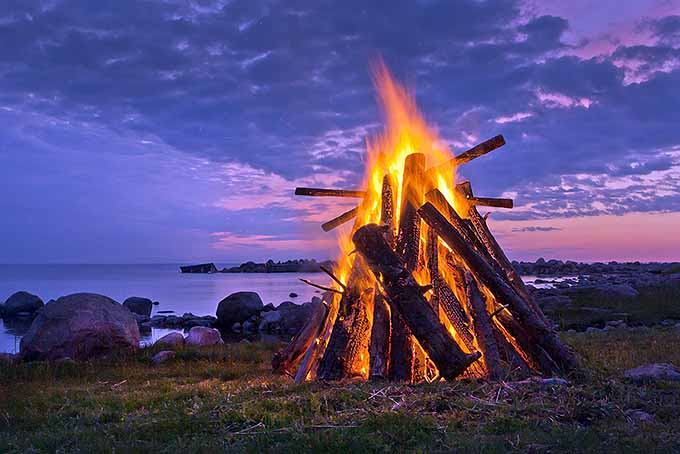
Ceremonial bonfires would have been lit, the cattle would have been brought down from their summer pastures, and other livestock would have been slaughtered for food.
This was a time to gather resources for the coming winter as well as to pay tribute to the tribal rulers.
As a sacred time, the Celts believed that the veil between the worlds of the dead and the living was at its thinnest on that day, and the Aos Si from the spirit realm could more easily enter our world.
The souls of the departed were also thought to take this time to revisit their homes and seek hospitality. As such, some historians believe that this was also a time used to commune with the dead.
To appease these spirits, the participants in the harvest festival performed various rituals. Food and drink would have been left outside for the benefit of the spirits.
For the visiting dearly departed, a place might have been set at the table for them to join in the harvest feast.
To confuse the spirits, some people would dress in costume or disguises and go door to door, offering prayers for the deceased in exchange for food.
These are just some of the customs and beliefs from pagan times that greatly influence the spooky ambience of our present-day Halloween.
Sometime after the Christianization of Ireland in the fifth century, the festival of Samhain merged with the Catholic feast of All Saints and became known as All Hallows Eve, or Hallowe’en. The Latin American equivalent, Dia de los Muertos, is observed around the same time.
When Did Trick-or-Treating Start?
In the ninth century, the Church shifted the date of All Saints Day to November 1 in an effort to stamp out these pagan customs, by giving the new converts something else to celebrate. But it didn’t work out quite as they intended.
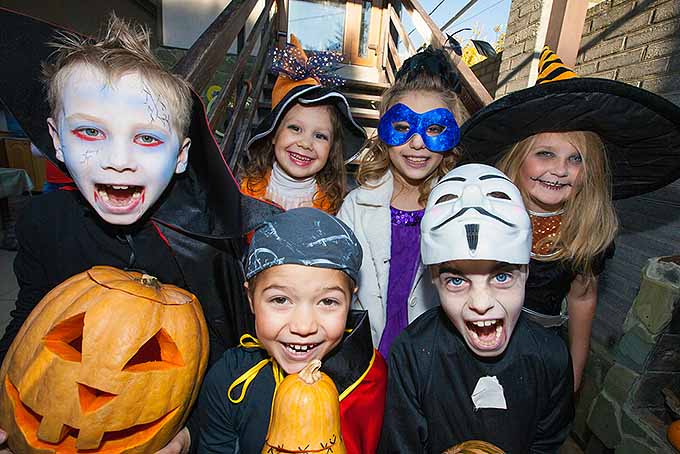
Instead, the new Christians simply intertwined their old rituals with their new beliefs.
The custom of dressing in costume and going door to door carried on much as it had before. In medieval Europe, “mumming” was a pretty common event at most celebrations, with people dressing up and acting out skits as part of the festival.
The evening before All Saints Day, people dressed up much as they always had. They went mumming around the village, knocking on doors, and asking for food in return for prayers for deceased loved ones.
In some parts of Europe, this custom was known as going “souling.” Participants believed the costumes they donned helped them to impersonate the deceased. The food items they received, known as “soul cakes,” were considered offerings to the dead.
A household would offer these soul cakes with the belief that this would bring good fortune, and protect them and their livestock throughout the winter season.
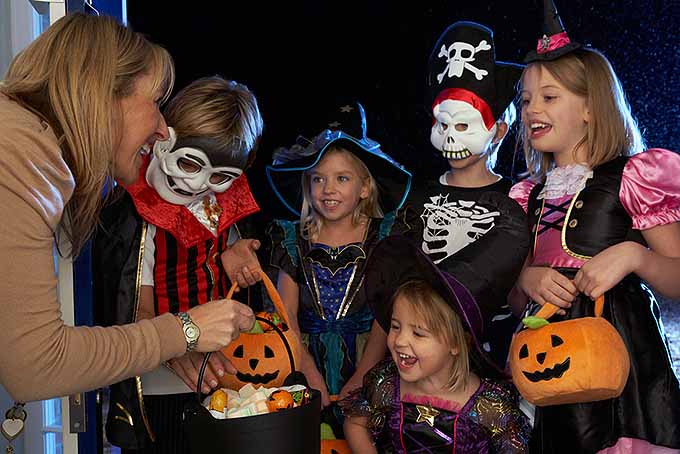
This early version of trick-or-treating was brought to North America during the colonial era when multiple waves of immigration took place.
A little later, during the 1800s, pranks on Halloween night became the norm. And oftentimes the pranksters took things a little too far.
By the end of the nineteenth century, to avoid having any malicious “tricks” played on them, townsfolk began offering “treats” as a bribe. Over time, this became more of a children’s pastime than something that the whole town would participate in.
The Origins of the Jack-o-Lantern
Wearing costumes and trick-or-treating aren’t the only Halloween traditions that we can attribute to the Irish.
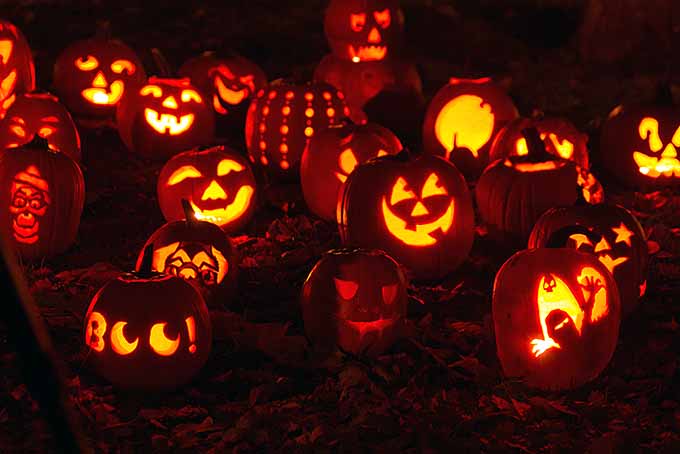
My most-beloved Halloween pastime, carving jack-o-lanterns, is also an Irish holdover from long ago. It was brought into the US after the potato famine of 1846 caused a massive influx of new Irish immigrants.
The Irish brought with them many traditions and customs that remain popular today, and I love all of them since they provide a link to my Irish heritage. This is one of my favorites.
According to an old Irish folktale, a drunken lout of a farmer named Jack died, and his evil dealings with the devil were so heinous they kept him out of both heaven and hell.
Forced to wander in the pitch blackness of purgatory for eternity, Jack carved a turnip and placed a burning coal inside to make a lantern to guide his lost soul.
Every Halloween, Irish communities would carve their own turnips and place them in the windows of their homes to scare away the cursed Jack, as well as any other wayward souls or spirits.
When the Irish immigrated to North America, the turnip lanterns became pumpkin lanterns, since this variety of winter squash was more common in the region than the Old World root vegetable.
Thus, the ubiquitous pumpkin jack-o-lanterns that grace our stoops and front porches every autumn in the present day.
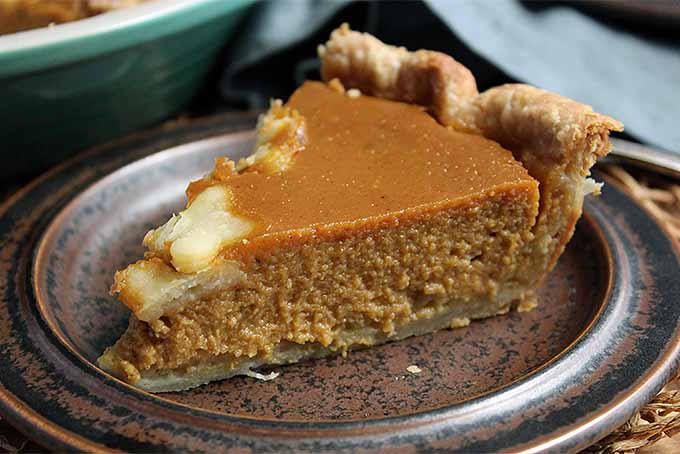
In our family we like to roast our pumpkin seeds after we clean out our jack-o-lanterns. If you’ve never roasted seeds yourself, Foodal has a great post that can show you how to do it.
Looking for more pumpkin recipes to add to your fall menu? Check out our twist on the classic pumpkin pie, this fantastic soup recipe, or give these pumpkin nut muffins a try.
What’s the Story Behind Our Favorite Seasonal Treats?
 When I went trick-or-treating as a little girl, folks were just as apt to hand out homemade treats as they were to offer store-bought candy. I really hate that this is a thing of the past, because those Halloween goodies were so good!
When I went trick-or-treating as a little girl, folks were just as apt to hand out homemade treats as they were to offer store-bought candy. I really hate that this is a thing of the past, because those Halloween goodies were so good!
If you’ve ever wondered how certain foods came to be associated with this fanciful holiday, look no further. We’ve got the scoop on all your favorites!
Rice Krispie Treats
Although Rice Krispie treats are fantastic at any time of the year, and additional flavors can make endless variations, for me these little treats will always be associated with Halloween.
Every year up until I was about 8 or 9 my great-grandmother would make up huge batch of these babies and wrap individual bars in colored plastic wrap to hand out to trick-or-treaters. They were hands-down my favorite Halloween snack!
Of course, I would have to take a break from traversing the streets to sit down in her house and eat a couple of treats right then and there, and then several more would make their way home with me in my pumpkin bucket.
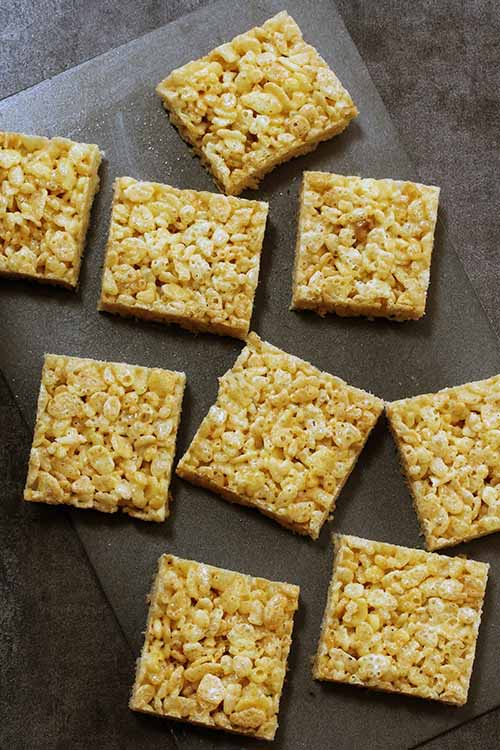
These tasty goodies originated back in 1939 when a Kellogg’s employee named Mildred Day, who was also a Campfire Girls troop leader, needed to come up with a fundraiser idea for her girls.
She based her concoction on a puffed rice brittle recipe from a 1916 cookbook penned by Lucy Maltby.
Her dessert bars were such a huge hit in her small town in Michigan that by 1941, Kellogg’s had trademarked the name and the recipe and started printing the recipe on the back of their cereal boxes. In no time at all, these delicious snacks were a commonplace item at many holidays, including Halloween.
Candy Corn
An easy way to jazz up your plain rice Krispie treats for this season is with the simple addition of some candy corn. If there’s a food item that says “Halloween” better than candy corn, I don’t know what it is.
You know the holiday is coming as soon as those bags of sugary goodness appear on your grocery store shelves, and I will be the first to throw a couple of bags into my shopping cart. But where did the idea for these even come from, and how did they come to epitomize this time of year?
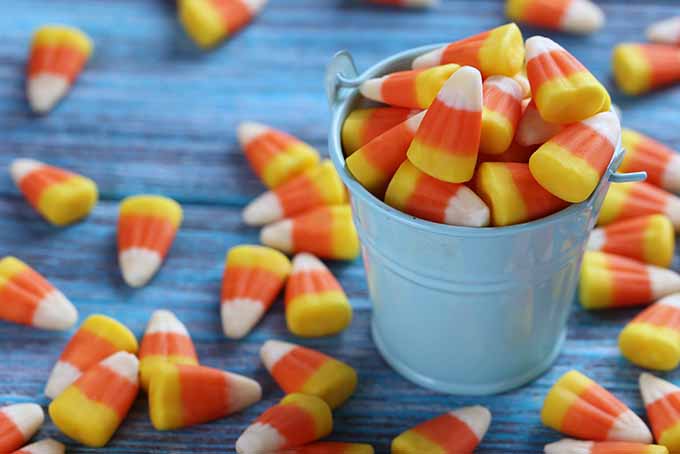
This sweet concoction was first created sometime in the 1880s by George Renninger, who was a candy maker with Wunderle Candy Company in Philadelphia. In 1898 the recipe was bought by Goelitz Confectionary Company, now Jelly Belly Candy Company.
Originally marketed as “chicken feed,” the candy became a huge hit, especially at Halloween. After the 1940s, once WWII sugar rations had been lifted, candy companies sought to take advantage of the harvest spirit at Halloween time and began to advertise candy corn and pumpkins as a holiday treat.
The candy corn with a chocolate end instead of a yellow sugar end is actually called “Indian corn” and was originally crafted specifically for the Thanksgiving season. It has become almost as popular as the original version and now hits stores in September, too.
Caramel, Candy, and Bobbing for Apples
Apples probably have the longest history associated with this time of year, having been a prominent decoration at many Samhain festivals in England dating back to the Roman occupation, with bobbing for apples possibly originating during that time period as well.
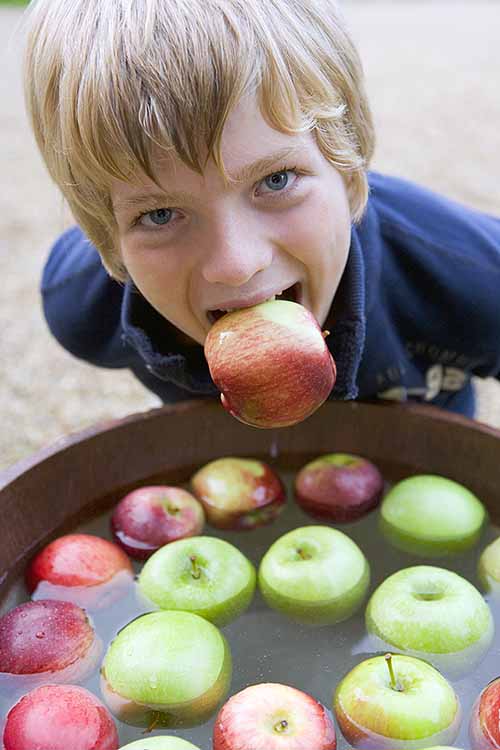
Sadly, since I’ve had children of my own, I haven’t seen this around as much at fall carnivals or Halloween parties. This was always so much fun when I was a kid, but I guess parents nowadays are too worried about germs and such to let their kids participate in a game like this.
My children’s pediatrician would probably just say that “it builds their immune system,” like she did when she walked in to find my one-year-old licking the floor. (In my defense, I was wrangling a 5- and a 3-year-old at the same time, so don’t judge!)
Anyway, you can be sure that if any event we attend this season has apple bobbing, my kids will be first in line.
Sacred Symbolism, Superstitions, and Apple Folklore
- Romans and Celts
The Romans brought the apple tree with them when they invaded Britain in 55 B.C., and they held it in esteem as a symbol of Pomona, their goddess of fruitful abundance.
Ancient Celts saw the five-sided star shape in the middle of the apple as a symbol of the sacred, and thus the apple took on special significance to them as well. They incorporated apples into their Samhain festival by tying some to evergreen boughs, as an offering to the spirits of their autumnal wealth.
Apples were also used in divination and fortune-telling in the pre-Christian era, even down to the seeds themselves.
- Bobbing for Apples
At some point during this period, some historians believe that apple bobbing first appeared, though we have no concrete evidence of this. We do have records of this activity in the medieval time period going forward, but over time it became less common.
It saw a resurgence in North America during Colonial times, especially in New England. By this time, though it was taken less seriously, the divination aspect was still a big draw.
Teenage girls were anxious to be the first to retrieve an apple from the water. And it was thought that the first girl to get her apple would be the next person to get married.
- Divination
A variation of this would be to hang the apples along a length of rope, and everyone would try to eat the apples without using their hands. It was thought the first to finish would be the next to marry.
Taking this a step further, after the girls had all gotten their apples, they would peel the fruit in one continuous strip, and then they would throw the long peel back over their heads. The peel was said to land in the shape of the first letter of their future husband’s first name.
Another superstition was for girls to put their bobbed apples under their pillows while they slept that night, and then they would see their future husbands in their dreams.
A creepier version of these superstitions was to eat your apple in front of a mirror by candlelight. It was said that you would see the reflection of your groom-to-be in the mirror beside your own face.
This has since evolved into the more modern Bloody Mary phenomenon, which I’ve never been brave enough to try myself!
For something a little bit sweeter, the first candy apples were made in 1908 when a Jersey-based candy maker named William Kolb decided to melt down some red cinnamon candy that he usually made for Christmas.
He decided to dip some apples in the melted candy and sold them for 5 cents each.
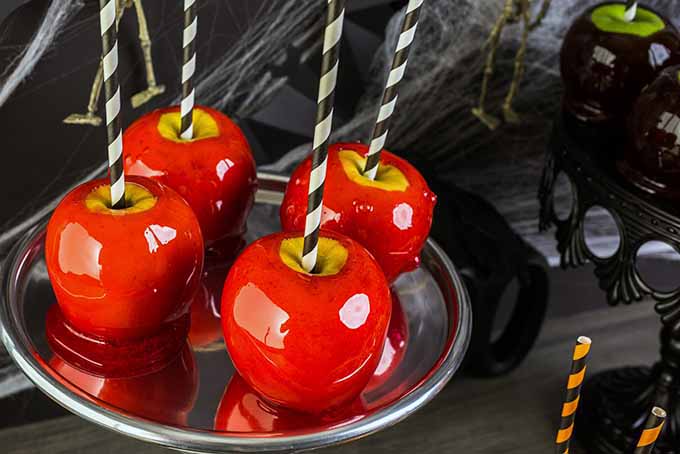
The caramel apple has a more recent history.
This sticky treat was actually created in the 1950s by a Kraft Foods employee who was experimenting with caramels leftover from Halloween sales. After melting some down, he decided to add apples, and the rest is history.
Due to the time of year when both of these treats were first created, these apple treats came to be associated with both fall and All Hallows Eve.

Peanut Butter Kisses
I know that I am in the minority here, but I am a big fan of those hard, little, peanut butter flavored candies that come in the orange and black wrappers. Most people don’t even know what they’re called!
Well, now you know: they’re called peanut butter kisses. The original candies were created in 1914 and were called Mary Janes, after the candy maker’s mother. While you can still find Mary Janes, there are tons of other candy companies making their own version of these, usually with the PB kisses name.
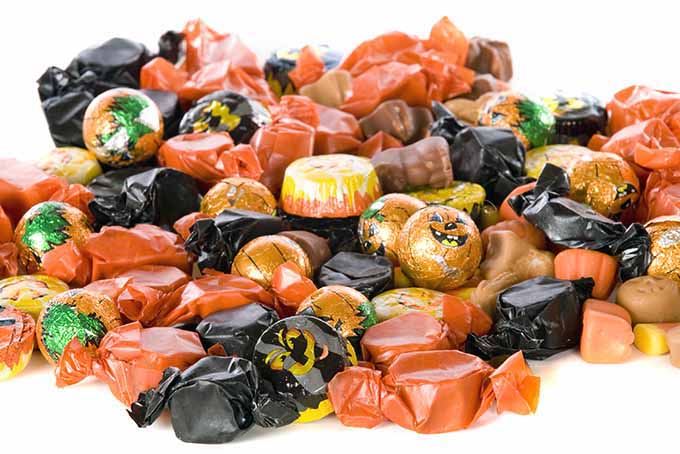
While the regular Mary Janes were sold in a rectangular shape and had a wrapper featuring an illustration of a little girl, most of the other candies are round and encased in orange and black wrappers. These candies are marketed specifically for Halloween.
Why orange and black? Black is the color most associated with death, and orange is often associated with fall and the harvest season, so it makes perfect sense that these are the official colors of the month of October in the US.
Popcorn Balls
Finally, the last item that really screams Halloween to me is the popcorn ball. We also enjoy them at Christmas time in our family, but I think they are more traditional for most people during this season.
Popcorn balls first became popular around the turn of the last century, and by the 1950s they were a common homemade treat given out to kids on Halloween. This was still the case for me as a little trick-or-treater in the 1980s.

Legend has it that the first popcorn balls formed naturally way back in 1874, when some extreme weather in Nebraska caused some corn to pop right in the fields.
Then, heavy rains made sorghum syrup leak right out of the canes and flow into the popped corn.
The river of syrup swept the popcorn into huge, perfectly-formed balls. Sadly, a swarm of grasshoppers ate them all up the next day!
Make the Holiday Memorable with Special Foods
No matter what holiday we are celebrating, it’s the foods that we share during that time that really brings the season to life.
Whether it’s candy corn or caramel apples, there are certain goodies that are de rigueur for your All Hallows Eve festivities.
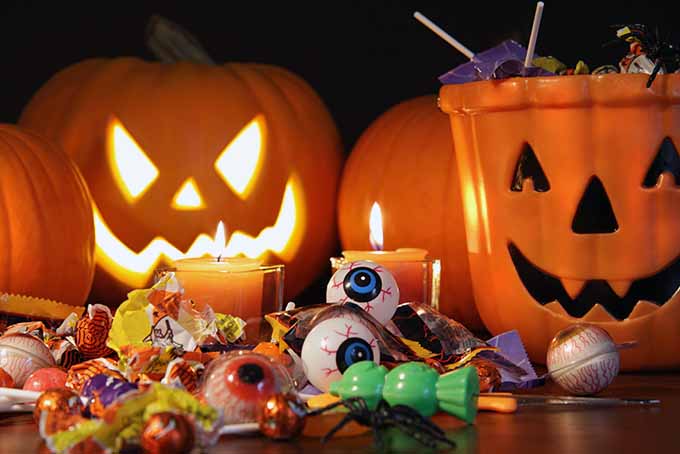
What are some of your favorite foods to eat at this time of year? Leave a comment below to let us know!
Pie photo by Kendall Vanderslice, © Ask the Experts, LLC. ALL RIGHTS RESERVED. See our TOS for more details. Uncredited photos: Shutterstock.
About Ashley Martell
Ashley has enjoyed creative writing since she was six years old, when she wrote her first short story. She majored in English literature at the University of Montevallo. After years of professional work, she is now a stay-at-home mom of three, who uses her craft to write about her life and adventures in and out of the kitchen.

